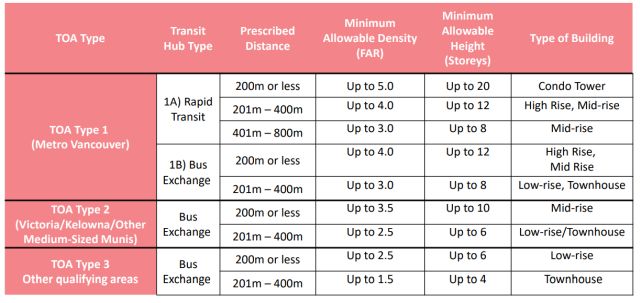Through various pieces of new legislation, British Columbia (the "Province") is pursuing some of the most significant changes to housing policy in decades.
Developers can expect their negotiations with municipalities for development approval of residential projects to be significantly affected by the following:
- Housing Statutes (Residential Development) Amendment Act, 2023 ("RDAA");
- Housing Statutes (Development Financing) Amendment Act, 2023 ("DFAA"); and
- Housing Statutes (Transit-Oriented Areas) Amendment Act, 2023 ("TOAA").
The stated goals of these legislative amendments include:
- Increasing housing supply with an emphasis on: (a) small-scale, multi-unit homes; (b) transit oriented areas; and (c) affordable housing;
- Reducing public hearing processes;
- Planning for long-term housing needs; and
- Providing developers and municipalities with a better understanding of certain costs related to a housing project at the beginning of the development process, rather than at the rezoning stage.
Key Changes for Developers Expected
While this new legislation will have many effects on developers, the following are likely the most impactful and widely applicable:
- A shift away from spot-zoning and site-by-site rezoning. Instead, small-scale, multi-unit homes will be zoned upfront, hopefully meaning fewer delays for developers looking to build this type of housing.
- Amenity cost charges ("ACCs") will only be imposed on developments that benefit from specific public amenities, and developers will only be responsible for the portion of capital costs allocated to new users. These costs will be better known upfront due to increased standardization and transparency. See below for more details on ACCs.
- Municipalities will be passing bylaws for higher density zoning around transit.
Residential Development Amendments Act (RDAA)
The RDAA encourages the development of small-scale, multi-unit housing by requiring municipalities to:
- Permit the development of three or four residential units on lots currently zoned single-family or duplex and up to six units on larger lots.
- Allow for secondary suites or laneway homes (subject to limited exemptions).
- Use their zoning authority to accommodate at least the number of housing units required to meet anticipated housing needs, without relying on density bonuses or "conditional density rules".
- Adopt amendments to their Official Community Plan ("OCP") by December 25, 2025 based on projected residential housing requirements for the next 20 years (rather than the previous five years) and have it updated every five years.
- Have all bylaws relevant to the above amended by December 31, 2025.
Under the RDAA, municipalities are prohibited from:
- Holding public hearings for by-laws that adhere to either the small-scale, multi-unit housing regulations or for projects that comply with OCPs1.
- Using ancillary land use management powers (such as development permits and heritage designations) to unreasonably prohibit or restrict the creation of housing units.
Development Financing Amendments
The DFAA changes the process by which municipalities presently raise funds for public amenities and infrastructure through community amenity contributions ("CACs"), development cost levies ("DCLs") and development cost charges ("DCCs"). ACCs will be calculable at the outset of a project. This is a departure from the current CAC process, which requires negotiation on a site by site basis. This is a welcome change for transparency, but only time will tell whether it will result in more housing or actually affect the amounts charged by local governments going forward.
Amenity Cost Charges (ACCs)
The DFAA regulates the amount a municipality can charge for an ACC by requiring:
- ACCs be similar for all developments that are expected to result in a similar increase in the population of resident and workers.
- Deductions from the capital cost of the applicable public amenity in an amount representative of the existing population of the area.
- ACCs be set relative to the size of the project and resulting increases in population. ACCs will not be payable if a development is not expected to result in an increase in the population of residents or workers.
- Other funding sources (including the local government itself) must be deducted from the estimated capital cost of the applicable public amenity.
- The public amenity being funded must be owned by the local government or owned by a person who has entered into a partnering agreement with the local government.
ACCs will only be imposed on developments that benefit from the specific amenities in question, and developers are only responsible for the portion of capital costs assigned to new users.
In regard to DCCs and DCLs, the DFAA requires that they be in line with the growth expected by the development project and subject to Provincial reporting and audit requirements.
Transit-Oriented Areas Amendments
The TOAA is focused on generating developments near major transit hubs. First, the TOAA requires that municipalities designate transit-oriented development areas ("TOD Areas"). Second, it demands municipalities have zoning bylaws in TOD Areas that meet specific requirements with respect to density, height and building type. These requirements will be impacted by a combination of factors including proximity to various types of transit and the metro area the TOD Area is located in.

Table prepared by the Province
Along with increasing density and height requirements around TOD Areas, this legislation removes minimum parking requirements for residential developments with certain exceptions such as for those with accessibility needs.
Footnote
1. Public hearings will still be required where local governments are updating their OCP or are considering rezoning that is inconsistent with their updated OCP.
The content of this article is intended to provide a general guide to the subject matter. Specialist advice should be sought about your specific circumstances.


